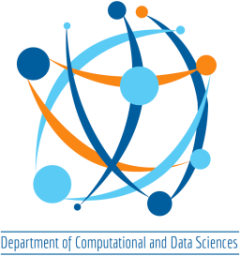[M.Tech. Project Topics] | [Project Topics from Jan, 2015]| [Project Topics from Jan, 2014]
Proposed M.Tech. Computational Science Project Proposals
Jan 2016
- Hybrid execution strategies for graph applications on GPU systems (Sathish Vadhiyar)
This project will look at building strategies for simultaneous use of both CPU and GPU cores in a GPU-based parallel system for efficient executions of graph applications including BFS, SSSP, satifiability problem, etc. The project will also explore efficient data organization strategies for fast access, and effective programming models for these applications on the GPU systems. - Auto-identifying scalability bottlenecks on large-scale systems (Sathish Vadhiyar)
This project will develop strategies and tools to automatically identify, and even auto-correct, performance bottlenecks in parallel applications that prevent scalability to a large number of cores. The work involves identifying different phases of a large-scale application, performance characterization of the phases, and pointing to causes for poor scalability. - Programming Environments and Processing Models for Efficient Executions on GPUs (Sathish Vadhiyar)
This project proposes to build easy-to-use programming environments and models that are supported with efficient optimized execution on GPUs. In particular, the project will focus on two parallel programming models, namely, asynchronous message-driven model and operator formulation model. The project involves a) building easy-to-use programming interfaces, b) compiler transformations for optimized executions of different programming models including asynchronous message-passing and operator formulation models and c) developing efficient runtime strategies for optimized execution on GPUs. - Scaling Molecular Dynamics application to a large-scale parallel system (Sathish Vadhiyar)
Molecular dynamics is an interesting parallel application with non-uniform computations and communications that vary over time and space. Providing parallelization with good scalability is challenging for this application. This project will build strategies to provide large-scale execution involving many thousand of cores. - HPC Application I/O patterns (J Lakshmi and SK Nandy)
On large-scale HPC systems I/O access can become the potential bottleneck for application scaling and performance. This project aims to identify the common I/O patterns of HPC applications currently running on a production system like the SahasraT of SERC to understand how applications conduct their I/O accesses. - Image Caption Generation using Deep Learning (Venkatesh Babu and Partha Talukdar)
Image caption generation is the problem of generating a descriptive sentence of an image. The fact that humans can do this with remarkable ease makes this a very interesting problem for AI, combining aspects of computer vision (in particular scene understanding) and natural language processing. This project aims to develop an algorithm for generating meaningful sentence descriptions of an image by leveraging on the recent advances in deep learning such as CNN and LSTM. - Unsupervised Feature Learning on Traffic Surveillance videos (Venkatesh Babu)
The objective of this project is utilize abundant traffic surveillance videos to learn visual features in an unsupervised manner. These features can be later used for tasks such as Anomaly Detection, Flow Analysis, Vehicle and pedestrian detection. By learning features specific to traffic videos, we hope to perform better at tasks relating to traffic
analysis. - Transfer learning for Crowd behavior analysis (Venkatesh Babu)
Crowd analysis is one of the key aspects of video surveillance. Learning a model in one scene and transferring that knowledge to another scene can help in better prediction of the crowd behavior, avoiding the tedious learning process for every situation. - Deep Learning for identifying Neural Signatures of Cognitive States (Venkatesh Babu and Sridharan Devarajan (CNS))
This project seeks to extend and apply the deep learning architecture to analyze spatiotemporal structure in brain activity recorded with human electroencephalography (EEG). The key challenge is to be able to identify cognitive states (e.g., whether a subject recognizes a visual scene, or to what object he/she is paying attention in a complex visual scene) based on recordings of brain activity. - Evaluation of Compressive Sensing Data Collection Strategies for Biomedical Imaging (Phaneendra K. Yalavarthy)
Compressive sensing has revolutionised the biomedical imaging in terms of speeding up the acquisition and lowering the instrumentation cost due to its requirement of having lower data compared to traditional imaging. The compressive sensing algorithms performance largely dependent on the incoherence of the available limited data and the standard of acquisition of this limited data is do random sampling. Recent developments have been focussing on lowering the algorithm complexity for biomedical image reconstruction, with greedy algorithms being the most sought after ones. This project will look at the data space and evolve strategies to effectively assess the data collection strategies without performing the image reconstruction step. These kind of evaluations are necessary in imaging the humans, as the true (or expected) image is unknown. - Development of Computationally Efficient Strategies for Fluorescence Image Denoising (Phaneendra K. Yalavarthy)
Image denoising has been a classic inverse problem and a routine image processing technique that is deployed to improve the image resolution/features. The fluorescence images of cellular and sub-cellular structures obtained in the microscope suffer from blur associated with the system response and aberrations. This blur is also spatially varying, denoising such images in not only challenging but very critical to obtain critical information. This project will develop efficient strategies for denoising such images and also evaluate them both numerically and experimentally for knowing their better utility. - Numerical analysis of error estimation algorithms for iterative
solutions of linear systems (Murugesan Venkatapathi)
Estimation of actual errors from the residue in iterative solutions is significant for efficient solution of large linear systems of unknown condition (numbers). In the recent past we have developed estimators of error for generalized linear sytems (non-symmetric,
indefinite etc.) solved using Bi-CG algorithm. Numerical analysis, improvements, and extensions of these estimators to other iterative methods such as GMRES are to be pursued. Related topics include estimation of quadratic forms, extremal eigen values, and condition number of matrices. - Methods for quantifying isomorphisms in graphs (Murugesan Venkatapathi)
Methods for quantifying similarities in structures of graphs
will be explored. Relevant methods will be studied using matrix algebra
and potential new parameters may be derived. Examples such as biological
networks may be tested on. - (Sashikumaar Ganesan) MTech project on one of the below topics is available at NMSC research group:
- Simulation of convection dominated two-phase flows with/without surfactants
- Finite element methods for high-dimensional (more than three) PDEs
- Efficient parallel solvers for large scale linear sparse algebraic systems
- Finite element methods for biomedical applications
- Any other topic that is relevant to the research areas of NMSC group
Interested candidates can send their research proposal (max. two pages) along with their CV to sashi-AT-serc.iisc.in by 15th Jan’2016. Note that the students with minimum 6.0 CGPA in their first term will only be considered.
Number of vacancy: 1 (2 – if the research proposals are exceptionally good) - Modeling and analysis of visual gaze strategies in an attention
game (Partha Talukdar and Sridharan Devarajan (CNS))
We seek to understand how subjects scan visual scenes and pay attention, sequentially, to various objects in the visual scene. The project will involve modeling and analysis of data collected in an eye-tracking experiment conducted on subjects playing an attention game. The goal is to analyze subjects’ eye-movement strategies in this attention game and to identify if specific patterns of eye movements are more predictive of success in the game, employing machine learning and multivariate statistical approaches. A related project is to build a deep convolutional neural network that can mimic subjects’ strategies at solving this game. - Inferring brain connectivity and network dynamics during attention (Partha Talukdar and Sridharan Devarajan (CNS))
Regions of the human brain dynamically organize into functionally coupled networks. Modeling the nature of these network interactions enables us to understand how the brain produces complex cognitive behaviors such as attention and decision making. This project seeks to employ a recently developed approach for modeling the brain as a discrete-time linear dynamical system and then uses a control-theory approach to identify functional connectivity between different brain areas. We will apply the model to functional magnetic resonance imaging (fMRI) data, and also investigate its success vis-a-vis more established approaches. - Representation learning for Knowledge Harvesting (Partha Talukdar)
This project will explore building on recent advances in representation learning and explore their applications for problems in knowledge harvesting. Prior experience with machine learning will be helpful. - Fog Computing for Complex Event Analytics (Yogesh Simmhan)
High velocity event streams data from Big Data applications like Internet of Things need to be processed in a distributed manner across edge devices like smart phones and Raspberry Pis which often the data stream source, and on the Cloud. This form of distributed execution across edge and Cloud is called “Fog Computing”. This project will examine distributed runtimes and scheduling of complex event processing using Fog Computing, and apply it to a Smart Campus project being conducted at IISc. - Distributed Graph Processing (Yogesh Simmhan)
This project will investigate Big Data platforms and distributed algorithms for large graphs such as social, knowledge and transportation networks. This includes developing new spatio-temporal analytics algorithms for traversals and mining, analyzing and tuning them for distributed execution, and performing comparative benchmarks on real graphs against Apache Giraph using public and private Clouds. - Big Data Platforms for Internet of Things (Yogesh Simmhan)
Internet of Things (IoT) is becoming a major source of Big Data as millions of sensors are deployed globally. This project will investigate the unique needs of Big Data platforms such as stream processing, NoSQL databases, visual analytics and runtime on smart phones to support IoT applications. The platforms and software architecture will support the Smart Campus project being conducted at IISc.



